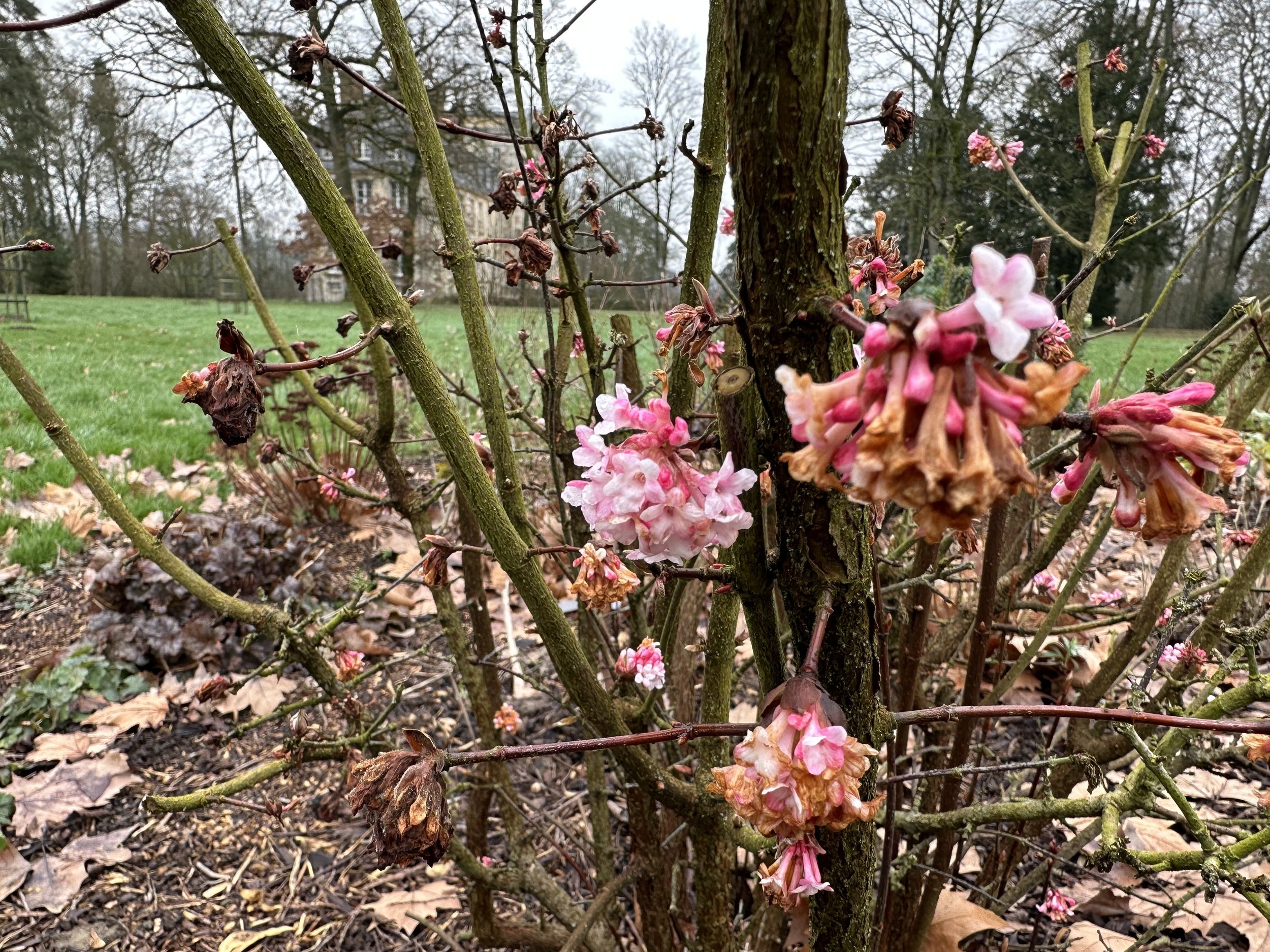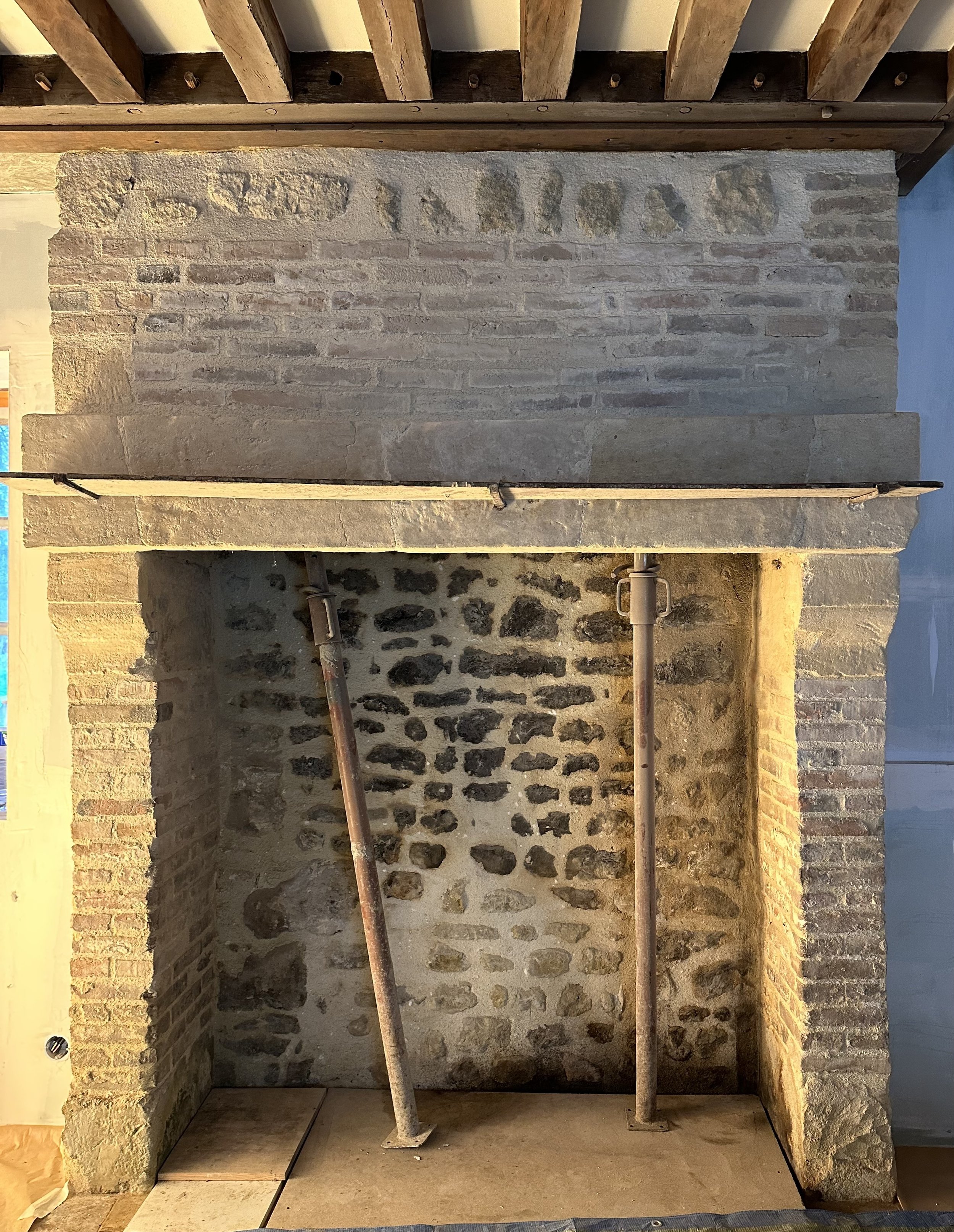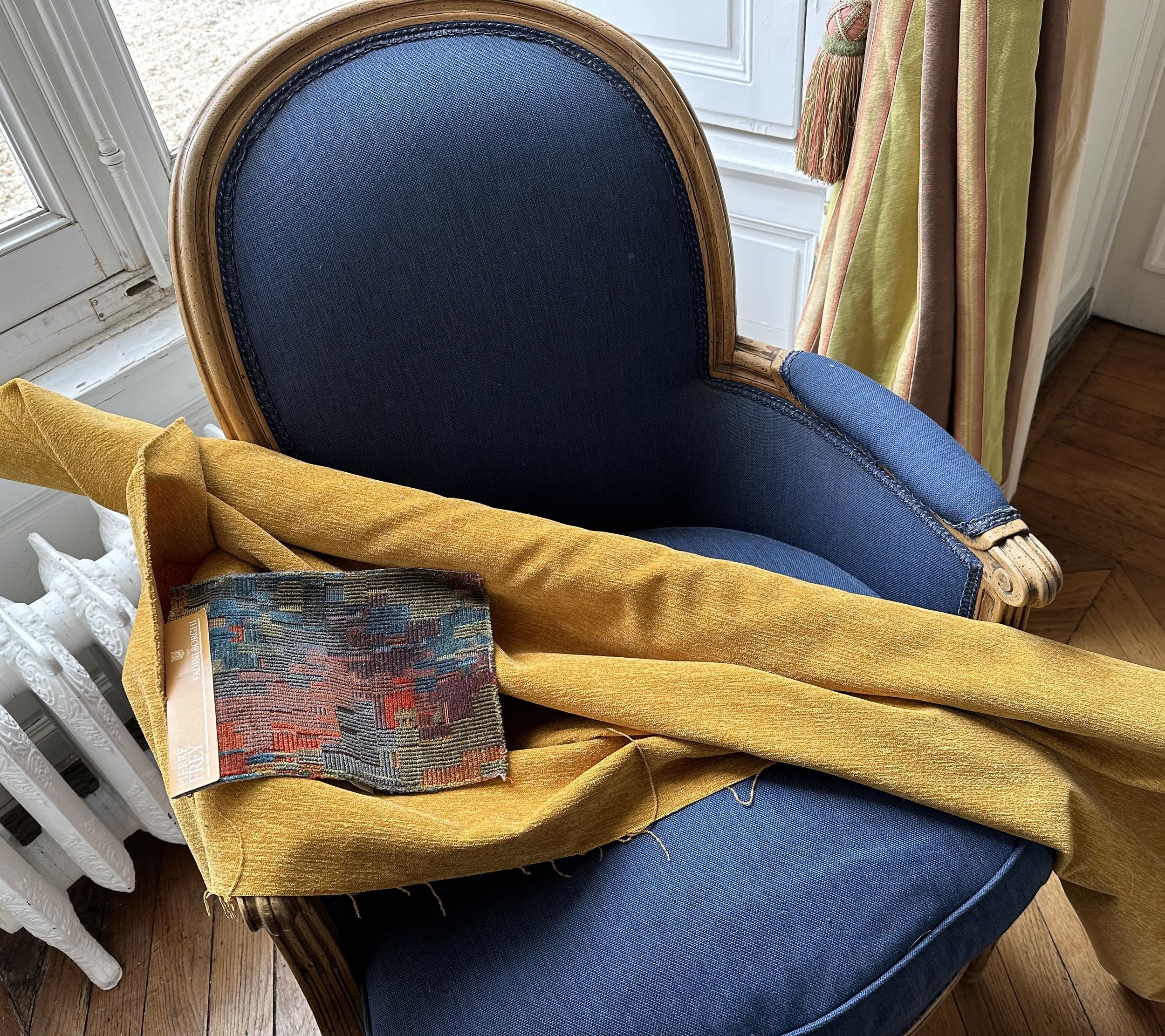Dark winter mornings, yet the garden begins to bloom
All winter, a lone pansy has bloomed against the farmhouse wall
Friday, February 16, 2024
Dear Valued Customer,
“C’est la Normandie,” remarked Monsieur Yves with resignation. Our farmer was loading hay bales for the cattle with the téléscopique. I had just left the farmhouse for a morning walk.
The cattle are doing well – so far. He taps the fence.
“Touche le bois!”
“And the pump?” he reminded me, anxiously. The farmyard pump brings water from Courtomer’s spring to the stabulations. Last year, it broke down and we had to switch to town water.
We looked up at the dreary skies, still dark despite the hour. The sun rises late in these Northern latitudes. At 8:30, dawn has just barely touched rosy-grey fingertips to the earth. And for the last few days, a gentle bruine intermittently dampens the air. It’s a mellow dampness, though, unlike the bone-chilling weather of January’s last quinzaine.
Suddenly, snowdrops have sprung up in the grove of trees next to the Chateau. I noticed their delicate white flowers one morning last week. Galanthus, meaning “milk flower” in Ancient Greek, is a wildflower. It seems to have originated in Greece and Italy and spread westward. In France, its native habitat is the Alpes, the Pyrenees, and the West, which includes Normandy. In the rest of the country, it has been naturalized – planted in the landscape or escaped from gardens.
We are busy naturalizing it, too. Last spring, Monsieur Martyn dug up clusters of the tiny bulbs from the grove and transplanted them to the park along the stream. He scattered them around the little stone obelisk on the edge of the woods.
Galanthus was first described in writing by the Greek philosopher and naturalist Theophrastus in the Fourth and Third centuries B.C. He called it “white violet.” During the winter festival of Matronalia, Roman maidens and matrons wore wreaths of it on their hair when they visited the temple of Juno, the mother of the gods.
Perhaps the ancestral bulbs of our snowdrops came to Courtomer with the Romans, homesick for the flowers of their natal paysage.
Or were planted in a garden here in the Middle Ages, when the first Chateau was built. The “perce-neige,” or “snow-piercer,” was a familiar flower in bowers and cloisters of medieval castles and abbeys.
A few of our snowdrops, just a few weeks ago. Now, they make a white and green carpet under the trees.
The blue-green spears of daffodils are erupting from the grass, too. Perhaps the Romans also brought these bulbs to Normandy in their baggage. The plants originated in the Iberian Peninsula, which Rome had conquered long before penetrating into Northwestern France. And daffodils were prized by the Romans. They planted them around the tombs of fallen warriors. In the ancient world, the flowers seem to have been associated with the realms of the dead from an early time. Persephone was picking daffodils when Hades, lord of the underworld, snatched her down into his lair.
When we first came to Courtomer, patches of daffodils still bloomed in the great lawn. Perhaps these were relics of a late 18th-century landscape park planted by the Marquis de Courtomer. Hélas! these clusters of jonquilles and narcisses perished several years ago beneath the ruthless lawnmower of our former jardinier. Like snowdrops and all perennial bulbs, daffodils survive on the energy gathered in their leaves. If mowed before the last yellowing leaves shrivel, they starve and die.
Gardening is about patience. And accepting some ugly passages for future reward. Perhaps that is why daffodils were planted over the heroic dead.
Later this morning, walking across to the haras under the leafless branches of pollarded lindens, I took a moment to inspect our small, circular shrubbery in the center of the cour d’entrée. As an example of my own gardening patience, I began planting it in the autumn of 2017.
Recently, Monsieur Martyn put in a few larmes de bergères, or hellebore, around the feet of the shrubs. The “tears of the shepherdess” fell on winter snow, as the legend has it, while she was admiring Christ in the manger. Her tears were transformed into flowers. These plants, too, are starting to blossom. Like snowdrops and narcissus, hellebore was probably once grown in a medieval garden at Courtomer. Not only was the Christmas Rose prized for its winter beauty, but the poisonous elebore was used as a purgative in medieval medicine.
Before Monsieur Martyn’s arrival, the shrubbery endured a stern regime of not entirely benign neglect. Vigorous specimens like viburnum bodnantense prospered. Meeker subjects sank into pallid decline. Under Monsieur Martyn’s watchful eye and careful application of compost, mulch, and water, all the plants are beginning to flourish.
Early this winter, he took a firm pair of clippers to the viburnum. Bodnantense soared above the other plants like an unruly flagpole. Monsieur Martyn wanted to dig it up. But I am fond of it, despite its ungainly vigor. Its tightly furled flowers attach to stems and branches like tenacious pink burs. Their scent, if only for a few short weeks in winter, is intensely sweet.
Ancestors of this hardy hybrid were probably planted in Courtomer’s landscape park by the Marquis or one of his successors. The viburnum species was a curiosity, initially sent home from North America by colonists. With the expansion of empire, new varieties were discovered in the Far East and India. One of bodnantense’s parents is a flowering, pungently scented small tree from the Himalayas. The botanist Nathaniel Wallich found it and named it viburnum grandiflorum while on an 1820s excursion up the Irrawaddy River to the Court of Ava, now part of Burma. Viburnum farreri, the other parent, gives bodnantense its fragrance. Farreri came to England from a plant-gathering expedition in Western China at the turn of the 19th century. The hybrid of these two subjects was made, to great acclaim, by Charles Puddle, head-gardener at Bodnant House in 1935.
Our ragged viburnum will soon be pruned into shape.
Meanwhile, out in the park, the newly planted hamamelis mollis is blooming, too. This witch hazel, like so many other ornamental garden plants, was also introduced to European gardens by an English plant collector. It was found in Eastern China by the botanist Charles Maries, on an 1879 expedition for the famed Veitch Nursery in England. Monsieur Martyn, perhaps like the Romans faithful to his natal country, put it in the new “spring garden” between the Atlas cedar and the woods.
Later in the day, I watch out the Chateau window as a lone poule d’eau darts around the moat. Perhaps she is starting to make her nest under the protection of dangling brambles and grasses along the bank. In the natural course of events, her first clutch of chicks will hatch in April. I am happy to note that the ragondin, voracious eater of waterlilies, is no more. At least, not in our moat. We wait, full of hope, to see if our nénuphars will grow back with warmer weather and longer days.
Spring is not far off.
Just before dawn, I heard the rouge-gorge, the merle noir, the grive musicienne begin to chirp and twitter. Martyn tells me they are practicing love-songs and territorial warning tweets for the mating season. These species – the robin, the blackbird, and the singing thrush -- live year-round on the grounds of the Chateau. They nest in the woods, in the allées of linden and horse chestnut, and in the ancient plane trees that surround the cour d’entrée. There is plenty of water in our streams and swampy places. They can eat dried wildflower seeds and berries. Exotic as they may be, the berries of the viburnum are welcome fodder, too.
Meanwhile, over in the stable block, hammers also sing.
After cleaning and repointing, the fireplace in the gatekeeper's cottage
La petite maison, the gatekeeper’s cottage attached to the remises à calèches – carriage houses -- and stables, has been under sporadic renovation for 14 years. We started the project again this autumn. This spring, we expect to have it habitable at last.
The electrician has finished his wiring, the walls are smooth and ready to paint with chaux, final coats of linseed oil and térébenthine are being applied to the floor, the menuisier has promised a new door sometime in the next few weeks. I am supposed to choose a woodstove, sinks, a bathtub, lighting, switches and plugs and, sadly, a new stove. The eyebrows of Monsieur Laurent, our maître d’ouvrage, shot up when he saw the old brass and enameled Godin cuisinière. He urged me to find a new model.
In the afternoon, Madame la tapissière arrives at the Chateau. Her arms are full of cushions. She carries in bolts of cloth. We are trying out various sizes and softness on the chairs and sofas in the grand salon and the bibliothèque. Just before Christmas, I’d been on an expedition to Paris to find fabric. Now, we drape les étoffes over cushions, hold up passementerie to find the right combination of rose twined with green for the salon, select cording and backing of a blue hue to match a border on the library curtains.
Didn't like the mustard after all, but the Italian cut valvet from Pierre Frey is a keeper for the library cushions.
Once these decisions were made, Madame Elodie brought in an armchair she’d recovered. This is one of a pair for the new boudoir up on the top floor. She carried it up two flights of stairs, panting only slightly. I helped her get it through the door to the boudoir and set it down on the new jute rug.
We stood at the threshold and looked at the overall effect.
Pale, like the inside of a shell. The armchair is upholstered in a heathered, light brown wool. The room is painted in a cream touched with pink. The sofa, a tone lighter than the armchair, almost blends into the walls. Muted blond of jute and soft rose tomettes cover the floor. The curtains are bronze silk.
I can see we are going to need some cushions.
Madame Elodie carried away a couple of chauffeuses as she went. These are low, upholstered chairs to put under the windows in the salon. I’m going to have a band of tapestry sewn over the seat and back to give them new life.
And I have plans for improving my office with a collection of antiquities and books about them. Le grand Edouard, family friend and our youngest son’s godfather, has left them in our keeping.
But perhaps this project will wait.
Monsieur Martyn has pointedly left a plant list on my desk. Monsieur Laurent has already sent two courriels about the bathtub and I can see he tried to call. Monsieur Yves wonders if the farmyard pump will hold.
Like a garden, Courtomer unfolds to its own imperatives.
Winter is coming to an end. Spring is beginning. A new season starts at the Chateau.
A bientôt,
P.S. If you would like to forward this email to a friend, please click here.
P.P.S. For "les chants d'oiseaux" sounding at Courtomer these mornings, listen to the grive musicienne (singing thrush), merle noir (blackbird) and rouge-gorge (robin) here
Or try these tracks, as I prefer. A paternal voice in French tells how to listen for these birds. On Studio les 3 becs, you can buy and download them.
At Chateau de Courtomer, we are taking bookings for 2025 and 2026. We still have a few opening for the Chateau, Orangerie and Farmhouse for 2024. Soon, we hope to open our "petite maison," the gatekeeper's cottage.
Heather (info@chateaudecourtomer.com and +33 (0) 6 49 12 87 98) will be delighted to help you with your enquiries and dates. And Jane will be happy to preview the property on site. She can also act as your concierge.
English and French spoken.
We look forward to hearing from you!





